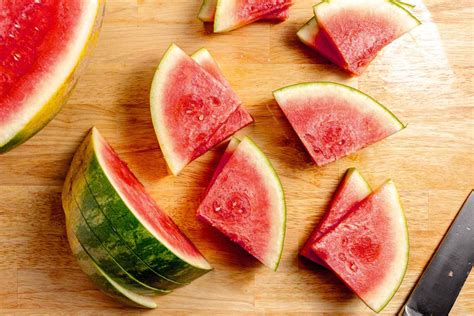
A food editor has revealed a simple method for slicing watermelon that eliminates mess and maximizes enjoyment, offering a quicker, cleaner alternative to traditional methods.
Food editor Mackenzie Filson, of “Taste of Home,” has unveiled what she claims is the ultimate watermelon-cutting hack, promising to revolutionize how people approach this summertime fruit. Her method focuses on creating easily manageable sticks of watermelon, perfect for snacking and minimizing the sticky mess often associated with the process. This approach distinguishes itself from conventional methods like cutting the melon into triangles or using a melon baller. Filson’s method provides a practical and less cumbersome way to enjoy watermelon, particularly beneficial for those seeking a quick and tidy snack solution.
Filson’s technique begins with halving the watermelon. Next, she places one half cut-side down on a cutting board and slices it horizontally, followed by vertical slices to create a grid pattern. This results in perfectly sized watermelon sticks that are easy to grab and enjoy. According to Filson, this method “gives you perfect little watermelon sticks.” The beauty of this technique lies in its simplicity and efficiency. It transforms a typically messy and cumbersome task into a quick and straightforward process. By cutting the watermelon into sticks, individuals can avoid the common pitfalls of handling large, unwieldy slices, such as juice dripping and uneven portions.
The appeal of this hack extends beyond mere convenience. It also addresses the practical challenges of serving watermelon at gatherings or packing it for picnics and lunches. The uniform size of the sticks makes portioning simple, ensuring that everyone gets an equal share. Furthermore, the stick format is ideal for younger children, as it provides a manageable and less messy way for them to enjoy the fruit. This method is particularly useful for parents who want to encourage healthy snacking habits without the added stress of dealing with sticky fingers and stained clothing.
Moreover, Filson’s approach to cutting watermelon aligns with the growing trend of prioritizing efficiency and convenience in food preparation. As people increasingly seek quick and easy solutions for everyday tasks, hacks like this one gain popularity for their ability to simplify complex processes. By streamlining the watermelon-cutting process, Filson has tapped into the desire for practical solutions that save time and reduce mess.
Filson’s watermellon-cutting technique has generated significant interest across social media platforms. Users have shared their experiences using the method, often accompanied by videos and photos demonstrating the process. The feedback has been largely positive, with many individuals praising the hack for its simplicity and effectiveness. Some users have even adapted the method to suit their specific needs and preferences, further highlighting its versatility.
The buzz surrounding Filson’s watermelon-cutting hack underscores the power of social media in disseminating practical tips and tricks related to food preparation. Platforms like Instagram, TikTok, and YouTube have become valuable resources for individuals seeking innovative ways to simplify cooking and meal preparation. The widespread sharing of these hacks has created a community of food enthusiasts who are constantly exchanging ideas and inspiration.
In addition to its practical benefits, Filson’s watermelon-cutting hack also has implications for food presentation. The uniform size and shape of the watermelon sticks make them ideal for creating visually appealing fruit platters and displays. Whether it’s a casual backyard barbecue or a formal dinner party, these watermelon sticks can add a touch of elegance to any occasion. The ability to present food in an aesthetically pleasing manner is an important aspect of culinary artistry, and Filson’s hack provides a simple yet effective way to enhance the overall dining experience.
The watermelon-cutting hack also resonates with individuals who are health-conscious and prioritize nutritious snacking options. Watermelon is a low-calorie, hydrating fruit that is packed with vitamins, minerals, and antioxidants. By making it easier to prepare and consume watermelon, Filson’s hack encourages people to incorporate this healthy fruit into their diets. This is particularly important in the context of rising obesity rates and the growing awareness of the importance of healthy eating habits.
Furthermore, the watermelon-cutting hack has implications for reducing food waste. By cutting the watermelon into uniform sticks, individuals are more likely to consume the entire fruit, rather than discarding uneaten portions. Food waste is a significant environmental problem, and any effort to minimize it is a step in the right direction. Filson’s hack promotes a more sustainable approach to food consumption by encouraging people to make the most of their fresh produce.
The success of Filson’s watermelon-cutting hack underscores the importance of culinary innovation and the constant search for better ways to prepare and enjoy food. Chefs, food bloggers, and home cooks are constantly experimenting with new techniques and ingredients, pushing the boundaries of culinary creativity. Filson’s hack is a testament to the power of simple ideas to transform everyday tasks and enhance the overall dining experience.
The trend of sharing food-related hacks and tips online has also contributed to a more democratized approach to cooking. In the past, culinary knowledge was often confined to professional chefs and experienced home cooks. However, the internet has made this knowledge more accessible to a wider audience, empowering individuals to experiment with new recipes and techniques. Filson’s watermelon-cutting hack is a prime example of how online platforms can democratize culinary knowledge and make it easier for people to enjoy delicious and nutritious food.
In conclusion, Mackenzie Filson’s watermelon-cutting hack is a simple yet effective solution for anyone who wants to enjoy this summertime fruit without the mess and hassle. Its practicality, convenience, and versatility have made it a popular choice among food enthusiasts and home cooks alike. By transforming a typically cumbersome task into a quick and straightforward process, Filson has tapped into the growing demand for efficient and innovative food preparation techniques. This hack not only simplifies the process of cutting watermelon but also promotes healthy snacking, reduces food waste, and enhances food presentation. As the trend of sharing food-related tips and tricks online continues to gain momentum, Filson’s watermelon-cutting hack is a testament to the power of simple ideas to transform everyday tasks and improve the overall dining experience.
The food editor’s revelation provides a practical solution for serving watermelon at gatherings, packing it for lunches, or simply enjoying it as a refreshing snack. The method also minimizes food waste, as the uniform cuts encourage the consumption of the entire fruit.
Building on the initial method, variations and adaptations have emerged online, demonstrating its versatility. Some users suggest using cookie cutters to create fun shapes for children, while others recommend adding a sprinkle of sea salt or a squeeze of lime juice for enhanced flavor. These modifications highlight the adaptability of Filson’s technique and its potential for personalization.
The core benefit of the hack lies in its ability to make watermelon more accessible and appealing. The traditional method of cutting watermelon often results in large, unwieldy slices that are difficult to handle and consume gracefully. By transforming the fruit into easily manageable sticks, Filson has eliminated this barrier, making watermelon a more convenient and enjoyable snack option for people of all ages.
The visual appeal of the watermelon sticks is another factor contributing to the hack’s popularity. The uniform size and shape of the sticks make them ideal for creating visually appealing fruit platters and displays. Whether it’s a casual backyard barbecue or a formal dinner party, these watermelon sticks can add a touch of elegance to any occasion. The ability to present food in an aesthetically pleasing manner is an important aspect of culinary artistry, and Filson’s hack provides a simple yet effective way to enhance the overall dining experience.
Beyond convenience and aesthetics, the watermelon-cutting hack also has implications for health and nutrition. Watermelon is a low-calorie, hydrating fruit that is packed with vitamins, minerals, and antioxidants. By making it easier to prepare and consume watermelon, Filson’s hack encourages people to incorporate this healthy fruit into their diets. This is particularly important in the context of rising obesity rates and the growing awareness of the importance of healthy eating habits.
Watermelon is rich in vitamins A and C, which are essential for maintaining healthy skin, boosting the immune system, and protecting against chronic diseases. It also contains lycopene, a powerful antioxidant that has been linked to a reduced risk of certain types of cancer. In addition to its vitamin and antioxidant content, watermelon is also a good source of potassium, which is important for regulating blood pressure and maintaining healthy heart function.
The watermelon-cutting hack can also be seen as part of a broader trend towards simplifying food preparation and making healthy eating more accessible. In today’s fast-paced world, people are increasingly looking for quick and easy solutions that fit into their busy lifestyles. The watermelon-cutting hack is a perfect example of this trend, as it offers a simple and efficient way to enjoy a healthy and delicious snack.
Moreover, the watermelon-cutting hack promotes sustainability by reducing food waste. When watermelon is cut using traditional methods, it is common for portions to be left uneaten due to their size or difficulty in handling. By cutting the watermelon into uniform sticks, individuals are more likely to consume the entire fruit, minimizing waste and maximizing the value of their purchase.
Food waste is a significant environmental problem, contributing to greenhouse gas emissions and depleting valuable resources. By adopting simple strategies like the watermelon-cutting hack, individuals can make a positive impact on the environment and promote a more sustainable food system.
The watermelon-cutting hack also underscores the importance of culinary creativity and innovation. Chefs, food bloggers, and home cooks are constantly searching for new and inventive ways to prepare and enjoy food. The watermelon-cutting hack is a testament to the power of simple ideas to transform everyday tasks and enhance the overall dining experience.
It is worth noting that the watermelon-cutting hack is not the only method for slicing watermelon that has gained popularity in recent years. Other techniques include using a watermelon slicer, which is a specialized tool designed to cut the fruit into even slices, and scooping out the flesh with a melon baller to create bite-sized portions.
While these methods may offer certain advantages, Filson’s watermelon-cutting hack stands out for its simplicity, versatility, and accessibility. It requires no specialized tools or equipment, making it a practical option for anyone who wants to enjoy watermelon without the fuss.
The watermelon-cutting hack also highlights the role of social media in disseminating culinary knowledge and promoting healthy eating habits. Platforms like Instagram, TikTok, and YouTube have become valuable resources for individuals seeking recipes, cooking tips, and food-related hacks.
The widespread sharing of Filson’s watermelon-cutting hack is a testament to the power of social media to connect people and inspire them to try new things in the kitchen. By showcasing the simplicity and effectiveness of the hack, social media has played a crucial role in its popularity and adoption.
The watermelon-cutting hack also has implications for the food industry. Restaurants, caterers, and food service providers can benefit from adopting this method to streamline their watermelon preparation process and improve the presentation of their dishes.
By cutting watermelon into uniform sticks, food service professionals can ensure consistent portion sizes, reduce waste, and create visually appealing platters and displays. This can enhance the overall dining experience for their customers and improve their operational efficiency.
In addition to its practical benefits, the watermelon-cutting hack can also be seen as a symbol of the changing landscape of food culture. In a world where convenience, speed, and aesthetics are increasingly valued, the watermelon-cutting hack offers a simple and effective way to meet these demands.
It represents a shift towards more accessible and user-friendly approaches to food preparation, reflecting the growing emphasis on healthy eating and sustainable practices. As food culture continues to evolve, it is likely that we will see more innovative and creative solutions like the watermelon-cutting hack emerge, transforming the way we prepare and enjoy food.
Furthermore, the technique encourages creativity in the kitchen. The uniform shape of the watermelon sticks allows for creative arrangements on platters or within recipes. They can be easily incorporated into salads, skewers, or even used as edible stirrers for cocktails. The hack provides a foundation for further culinary exploration, inviting users to experiment with different flavors and presentations.
The adoption of this method can also reduce the risk of accidents in the kitchen. Traditional watermelon cutting methods, which often involve maneuvering a large, slippery fruit with a sharp knife, can be hazardous. The stick method simplifies the process, reducing the need for awkward handling and minimizing the risk of cuts or injuries.
From a business perspective, the watermelon-cutting hack can be adopted by restaurants and food vendors to improve efficiency and reduce waste. By pre-cutting watermelons into sticks, they can streamline their service and reduce the time it takes to prepare orders. This can be particularly beneficial during peak seasons when demand for watermelon is high.
In summary, the watermelon-cutting hack is a simple yet revolutionary technique that offers a multitude of benefits, ranging from convenience and health to sustainability and safety. Its widespread adoption reflects a growing desire for efficient, accessible, and creative solutions in the kitchen.
Filson’s method also highlights the value of sharing knowledge and expertise. As a food editor, she has a platform to share her culinary insights with a large audience. By doing so, she is empowering individuals to improve their skills and enjoy the benefits of healthy eating.
The hack is not just about cutting watermelon; it’s about making a healthy and delicious fruit more accessible and enjoyable for everyone. It’s about simplifying a task that many people find daunting and turning it into a fun and rewarding experience.
In conclusion, the watermelon-cutting hack is a testament to the power of simple ideas to transform everyday tasks and improve our lives. It’s a reminder that innovation doesn’t always require complex technology or expensive equipment. Sometimes, the best solutions are the simplest ones.
Frequently Asked Questions (FAQ)
1. What exactly is the watermelon-cutting hack being promoted?
The watermelon-cutting hack, popularized by “Taste of Home” food editor Mackenzie Filson, involves cutting a watermelon into manageable sticks for easy snacking. The technique begins by halving the watermelon, placing one half cut-side down, and then slicing it horizontally and vertically to create a grid pattern, resulting in watermelon sticks. Filson states this provides “perfect little watermelon sticks.”
2. How does this watermelon-cutting method differ from traditional methods?
Traditional watermelon-cutting methods often involve slicing the melon into large, triangular wedges or using a melon baller to scoop out individual portions. Filson’s method stands apart by producing uniform sticks, making the fruit easier to handle, less messy to eat, and ideal for portion control. This technique eliminates the need to navigate large, unwieldy slices and reduces the risk of dripping juice.
3. What are the benefits of using this watermelon-cutting hack?
The benefits of this watermelon-cutting hack include:
- Convenience: The sticks are easy to grab and eat, making watermelon a more convenient snack.
- Reduced Mess: The uniform size of the sticks minimizes dripping and mess compared to traditional slices.
- Portion Control: The sticks are ideal for portioning, ensuring that everyone gets an equal share.
- Kid-Friendly: The stick format is manageable for children, making it easier for them to enjoy the fruit.
- Presentation: The sticks can be arranged attractively on platters and in recipes.
- Reduced Food Waste: Encourages consumption of the entire fruit.
4. Is this watermelon-cutting method safe, especially for children or those with limited knife skills?
Yes, this method is generally considered safe when performed with caution. The key is to use a sharp knife and a stable cutting board. Placing the halved watermelon cut-side down provides a stable base, reducing the risk of slipping. Children should always be supervised when using knives, and adults with limited knife skills should proceed slowly and carefully. Consider using a smaller, more manageable knife if preferred.
5. Can this watermelon-cutting hack be adapted or modified?
Yes, the watermelon-cutting hack is highly adaptable. Some users have suggested using cookie cutters to create fun shapes for children. Others recommend adding a sprinkle of sea salt or a squeeze of lime juice for enhanced flavor. You can also adjust the size of the sticks to suit your preferences. For example, you can create thicker sticks for grilling or thinner sticks for adding to salads. The method serves as a versatile base for culinary creativity. 6. What kind of Watermelon should be used for this “Hack”?
This hack works well with most seedless watermelons. Seeded watermelons can also be used, but the process might require more attention to remove the seeds while cutting. Personal watermelons (smaller varieties) are also suitable, especially for individual servings. The size and type of watermelon can be adjusted based on your needs and preferences.
7. What tools are needed for this watermelon-cutting hack?
The essential tools needed are: A sharp knife (chef’s knife or similar). A stable cutting board.
Optional tools that can enhance the process include: A watermelon slicer (though not necessary). Cookie cutters (for creating fun shapes). *A serving platter or bowl.
8. How can I prevent the watermelon from slipping while cutting?
To prevent the watermelon from slipping, ensure your cutting board and the watermelon surface are dry. Placing a damp paper towel or a non-slip mat underneath the cutting board can also provide extra stability. When cutting, maintain a firm grip on the watermelon and use a sharp knife to minimize the need for excessive force.
9. Can the watermelon sticks be stored, and if so, how long will they last?
Yes, watermelon sticks can be stored in an airtight container in the refrigerator. They are best consumed within 2-3 days to maintain their freshness and flavor. Over time, the watermelon may release more liquid and become slightly less firm.
10. Are there any other creative ways to use these watermelon sticks besides snacking?
Yes, watermelon sticks can be used in various creative ways, including: Adding them to salads for a refreshing touch. Grilling them for a caramelized flavor. Making watermelon skewers with feta cheese and mint. Using them as edible stirrers for cocktails. Blending them into smoothies or juices. Freezing them to make watermelon popsicles.
11. How does this method compare to using a watermelon slicer tool?
A watermelon slicer tool can quickly create uniform slices, but it may not be as versatile as the stick method. The stick method allows for more control over the size and shape of the pieces, and it doesn’t require a specialized tool. Additionally, the stick method can be easier to clean up, as it avoids the mess of handling large, wet slices.
12. What are the potential drawbacks of this watermelon-cutting hack?
The primary drawback is that it can be slightly more time-consuming than simply cutting the watermelon into wedges. However, the benefits of convenience, reduced mess, and portion control often outweigh this minor inconvenience. Additionally, some individuals may find it challenging to create perfectly uniform sticks, but with practice, the technique becomes easier.
13. How does this method help in reducing food waste?
This method helps reduce food waste by making watermelon easier to consume. Traditional methods often result in uneaten portions due to the large size and messiness of the slices. By cutting the watermelon into manageable sticks, individuals are more likely to eat the entire fruit, minimizing waste. Additionally, the uniform size of the sticks makes it easier to store and use leftover watermelon in other recipes.
14. Does the ripeness of the watermelon affect the success of this cutting hack?
Yes, the ripeness of the watermelon can affect the success of this cutting hack. A ripe watermelon will be easier to cut and will produce cleaner, more uniform sticks. Overripe watermelons may be too soft and mushy, making it difficult to maintain the stick shape. Choose a watermelon that is firm to the touch and has a hollow sound when tapped.
15. Are there any nutritional benefits to eating watermelon cut in this particular way?
No, the nutritional benefits of eating watermelon are the same regardless of how it is cut. Watermelon is a good source of vitamins A and C, lycopene, and potassium. The cutting method primarily affects the convenience and presentation of the fruit, not its nutritional value.
16. How can I make this watermelon-cutting hack even more efficient?
To make the hack even more efficient: Use a very sharp knife to minimize effort. Prepare a large cutting board to accommodate the watermelon size. Have a designated container ready to transfer the sticks. Consider pre-cutting several watermelons at once if you’re serving a large group.
17. What are some safety tips to keep in mind while using this hack?
Safety tips include: Always use a sharp knife to prevent slipping. Cut on a stable, non-slip surface. Keep your fingers away from the blade’s path. Supervise children if they are helping with the cutting. *Take breaks if you are cutting a large number of watermelons to avoid fatigue.
18. How does this method compare to using a melon baller?
Using a melon baller creates bite-sized portions of watermelon, which can be aesthetically pleasing. However, it can be more time-consuming than the stick method and may result in more waste, as it’s difficult to scoop out all the flesh. The stick method offers a balance between convenience and presentation.
19. What are some creative ways to present the watermelon sticks?
Creative presentation ideas include: Arranging the sticks in a rainbow pattern on a platter. Serving them in individual cups with a dipping sauce (such as honey-lime). Creating a watermelon “tower” by stacking the sticks vertically. Garnishing them with fresh mint or basil leaves.
20. Can this watermelon-cutting hack be used for other fruits as well?
While primarily designed for watermelon, this hack can potentially be adapted for other large, soft fruits like cantaloupe or honeydew melon. However, the results may vary depending on the fruit’s texture and shape. The key is to ensure the fruit is firm enough to hold its shape when cut into sticks.









